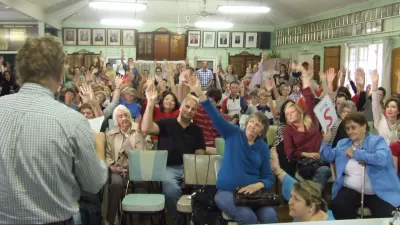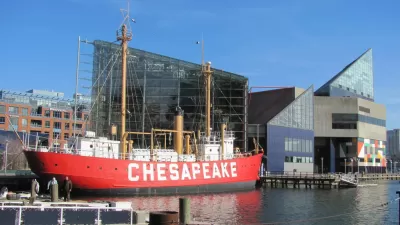The city of Albuquerque is focused on bringing consistency and coherence to an unwieldy collection of planning and land use regulations. An interview with Albuquerque Planning Director Suzanne Lubar explores the city's approach to the challenge.

Contrary to its image in pop culture, Albuquerque is not the methamphetamine capital of America. And yet, there is a grain of truth to the adventures of Walter White: Albuquerque is overwhelmingly suburban. The stucco tract home, the muscle car, and the backyard swimming pool are all more or less real. Of course, such is the case across much of the American West. In the case of Albuquerque, those pleasant homes belie the existence of arguably the most complex land use regulations in the entire country.
A lawyer by trade, Albuquerque Planning Director Suzanne Lubar was hired not so much to rebuild Albuquerque as to bring it a semblance of functionality to its regulations. That process is well underway. Once the paperwork is done on the city's zoning code and comprehensive plan, the city will turn to the challenge of remaking itself to be more appealing to younger generations—of the type who want to open businesses and build on New Mexico's rich history of technological innovation. Lubar spoke recently with Planetizen's Josh Stephens for the latest installment of the "Planners Across America" series.
What major initiatives are you pursuing now?
When Mayor (Richard) Berry appointed me to the position, he asked me to take a fresh set of eyes to see what was going on in the industry and figure out what we could improve upon.
 I sat down with the managers to find out the needs and issues. One that came up quickly was the fact that our comprehensive plan was originally adopted in 1988 and our zoning code was originally written in 1976. On top of that, we had 60-plus sector plans, or small area plans, that not only had their own policies but also their own regulations and unique zoning, different than what our zoning code provided.
I sat down with the managers to find out the needs and issues. One that came up quickly was the fact that our comprehensive plan was originally adopted in 1988 and our zoning code was originally written in 1976. On top of that, we had 60-plus sector plans, or small area plans, that not only had their own policies but also their own regulations and unique zoning, different than what our zoning code provided.
When you added up all our zones, we had over 1,150 zone categories. It had become untenable to be able to accurately and fairly implement all of that.
We needed to update our comprehensive plan but we also needed to look at our zoning code, our subdivision ordinance, and our development process manual. We ultimately decided that we needed to do an update of our comp plan to make sure it reflected the vision of our community and then to essentially rewrite our zoning codes so we would have the tools to implement that vision.
How did you approach that undertaking?
What we ended up deciding to do was pretty aggressive and, according to our consultants, a little bit crazy: we decided to take on everything at one time.
We are in the midst of creating an Integrated Development Ordinance (IDO), which will include a revised planning ordinance, subdivision ordinance, zoning code, and land development process manual. Everything will be located in one book.
We have a picture that shows just a sample of our current regulation. The stack is probably 2-3 feet high. Our proposed comprehensive plan and Integrated Development Ordinance is maybe 2-2.5 inches high. We're trying to get all the policy into the comprehensive plan and get all of the regulations into the IDO.
That's proving to be an enormous project. We've been working with Don Elliott at Clairion Associates. He knew that Albuquerque had a lot of issues. But it wasn't until he really got into it that he realized we probably had the worst system in the country. He’s trying to help us plow through that.
The updates to the comp plan are at City Council and hopefully will be adopted soon. The IDO draft has been submitted to our Environmental Planning Commission for their review and recommendation.
Will these reforms be mainly bureaucratic and systems reforms, or will they have significant impacts on the built environment?
They will have both.
One of the issues in Albuquerque is distrust between the neighborhood associations and the developers. This distrust has built up over many years. Frankly, the sector development plans were created as Band-Aids, as fixes to the zoning code.
A lot of areas in Albuquerque decided that they each wanted their own sector plans to protect their neighborhoods. About half the city is covered in sector plans, and there are some really good things in them.
We're trying to take the best practices and try to apply them to the entire city. For instance, if it's good for one neighborhood to have buffers between commercial and residential, why not have those same benefits for the entire city? And we are trying to achieve a connection between land use and transportation, allowing higher density along our major transit corridors, and allow for mixed use and complete streets in the appropriate places.
A lot of development has to go through our Environmental Planning Commission. There tends to be a lot of negotiating, arguing, and appealing of decisions. We're trying to raise the bar in terms of the quality and design standards that we're going to expect of developers. In return, we’re trying to reduce cases that go through the commission. We're trying to bring the neighborhoods into the discussion sooner and make our processes more understandable to the neighborhoods and developers.
One of the concerns we hear is, "you're trying to make it simpler for developers to ruin our city." That’s not the goal. The goal is to have high-quality development that’s more collaborative and a more positive experience.
What are the social trends and land use trends you’re seeing?
Like much of the country, we're trying to make Albuquerque an inviting place for all of our residents. And we want to retain our Millennials, many of whom are leaving Albuquerque for a variety of reasons. Some leave for jobs, some because they don't think we're a happening place to be.
At the same time, we have a fairly significant aging population. We have a lot of Boomers who have retired here. One of the things we don’t have is a real a diversity of housing opportunities.
We have a very suburban layout. That's wonderful and it has its place. But a growing number would like to live in a more urban environment. We want to increase the urban presence for places where people can live, work, and play.
You are not a planner by training. What does it mean for you to be a lawyer-planner?
Prior to working for the city, I worked with private commercial developers, on the other side of the table, so to speak. I worked on entitlement issues, buying and selling land, and whatnot.
I came to the city during the recession to be the Real Property Division manager. The mayor asked me if I would be the director of the Planning Department. I looked at him like, "why me? I'm not a planner. I'm not an architect. I don't know what to do." He said, "no, you are a lawyer, you have a real estate background, you're an administrator, and that’s what we need."
I came over here with a lot of trepidation. What I realized was that my background gave me a unique perspective on some of the issues the Planning Department had both in terms of customer service and in terms of our regulation processes.
I was able to bring them the perspective that "this policy may be a utopian ideal, but will the market bear it? Will any developer want to develop that?" I wanted the planners and plan reviewers to think about that and compel them to communicate with developers, engineers, and architects about the realities of what they were being asked to do. My staff helped me grow and learn about planning. I hope I've helped them grow as well.
As you've learned about planning, there any scholars or mentors who have helped you appreciate the field of planning?
I credit my staff. I have the most amazing planning staff ever. Russell Brito, our urban design and development manager, has been a phenomenal teacher to me. He may not be known on the national scale, but he has my undying support and gratitude.
The mayor has been an amazing supporter of the Planning Department and everything we've been doing. When he said take a fresh set of eyes, he wasn’t kidding. He genuinely wanted that.
Are there other cities, either in the Southwest region or cities of similar sizes nationwide, that you look to for inspiration or commiseration?
The city that we looked to help us decide that it was time have an integrated development ordinance, rather than a bunch of separate documents, was Raleigh, N.C. (see "Planners Across America" interview with Raleigh's Ken Bowers). They had just finished their Uniform Development Ordinance when we were just starting to looking at the problem. We took inspiration in the fact that they were able to get that done and that it made sense.
We've also looked to Denver a bit; some of their western issues are similar to ours. On occasion we look to Phoenix, El Paso, San Diego. I'm not a big believer in reinventing the wheel, so when we have certain issues, I ask my staff to reach out to other cities and people in the field to see how they’ve managed things.
What internal reforms have you implemented?
Almost everything we did lived in paper-based manual recording. We've put a lot of effort into maximizing the use of technology and hopefully making our processes easier.
We're bringing the Planning Department into the 21st century. We initiated E-plan, which is where plans can be uploaded online and simultaneously sent to all reviewers. It has expedited our process and made it much less reliant on people submitting ten sets of paper plans and burning all those trees.
We're also implementing case-management software that will allow our clients to make applications online and pay fees online with credit cards. Our inspectors have mobile capabilities. They can record their inspections on tablets out in the field. We’ve also created a real property database so the city can know what property it owns. We're implementing a Yardi lease administration and work order system for all of our property management.
Conducted in January, this interview has been condensed and edited for clarity.

Planetizen Federal Action Tracker
A weekly monitor of how Trump’s orders and actions are impacting planners and planning in America.

Map: Where Senate Republicans Want to Sell Your Public Lands
For public land advocates, the Senate Republicans’ proposal to sell millions of acres of public land in the West is “the biggest fight of their careers.”

Restaurant Patios Were a Pandemic Win — Why Were They so Hard to Keep?
Social distancing requirements and changes in travel patterns prompted cities to pilot new uses for street and sidewalk space. Then it got complicated.

California Homeless Arrests, Citations Spike After Ruling
An investigation reveals that anti-homeless actions increased up to 500% after Grants Pass v. Johnson — even in cities claiming no policy change.

Albuquerque Route 66 Motels Become Affordable Housing
A $4 million city fund is incentivizing developers to breathe new life into derelict midcentury motels.

DC Area County Eliminates Bus Fares
Montgomery County joins a growing trend of making transit free.
Urban Design for Planners 1: Software Tools
This six-course series explores essential urban design concepts using open source software and equips planners with the tools they need to participate fully in the urban design process.
Planning for Universal Design
Learn the tools for implementing Universal Design in planning regulations.
Heyer Gruel & Associates PA
JM Goldson LLC
Custer County Colorado
City of Camden Redevelopment Agency
City of Astoria
Transportation Research & Education Center (TREC) at Portland State University
Camden Redevelopment Agency
City of Claremont
Municipality of Princeton (NJ)





























